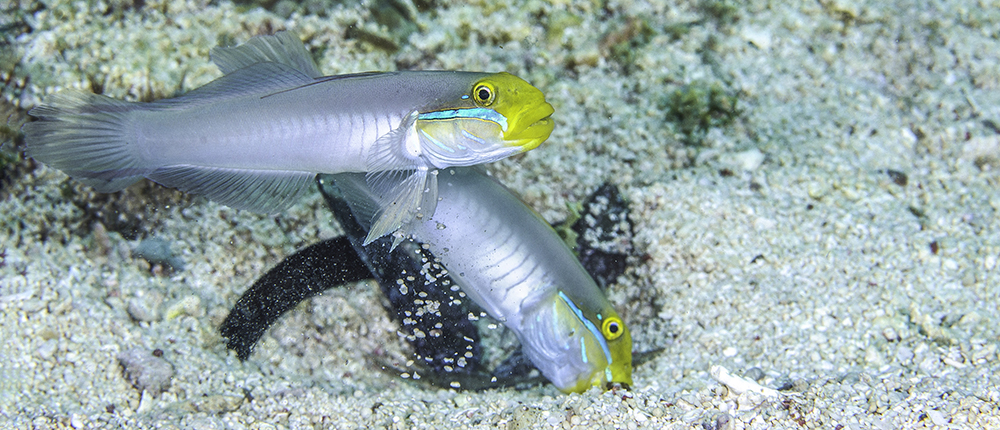Sand Dwellers of Wakatobi
The coral reefs of Wakatobi are often lauded as some of the most pristine and bio-diverse in the world. Such praise is certainly justified, and we work diligently to ensure our reefs continue to receive the protections needed to ensure their continued health. But there’s more to our underwater attractions than corals, and even areas that may seem barren to humans at first glance can be quite fascinating when you take a closer look. This includes the seemingly barren patches of sand bottom in bays, slopes, and open areas between coral formations. Let’s take a closer look at the sand dwellers of Wakatobi.
The Homesteaders
There are a number of marine animals that dig in and make their homes on Wakatobi’s sandy seafloors. These aquatic excavators move sand and rock to create a safe haven in open terrain. Among the more entertaining burrowers are the jawfish. As you approach, a jawfish may rise up a few inches from the bottom, raising its fins and flaring its gill covers in a display of territorial aggression. Move closer and they will likely retreat into the safety of their burrow. But if you remain still and don’t create a lot of racket, in time they may re-emerge and return to business. For a jawfish, burrow maintenance is an ongoing chore. You’ll often catch them popping up from their hole with a mouthful of sand, which is spit out and possibly exchanged for a small rock or shell, which will be dragged below and used to shore up the burrow walls.
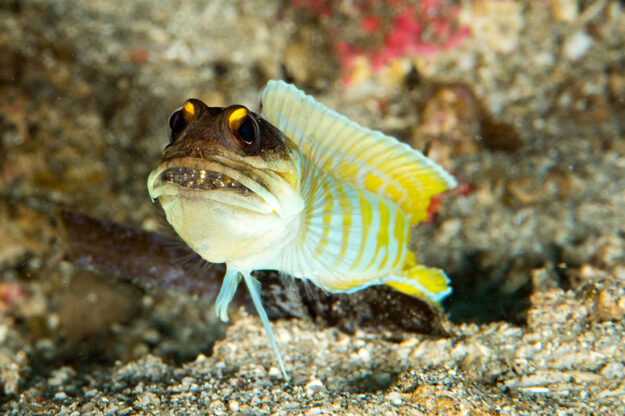
After a spawn, the male jawfish will take custody of the eggs, which are carried in their mouths. Photo by Wakatobi Resort
Jawfish live alone, save for brief interludes when a couple may share a hole during mating season. After the spawn, it is the males who take custody of the eggs, which are carried in their outsized mouths. When not playing dad, the males can be quite territorial. If one excavates too close to another’s existing burrow, the ensuing turf war will involve a lot of posturing and possibly some jousting with jaws agape.
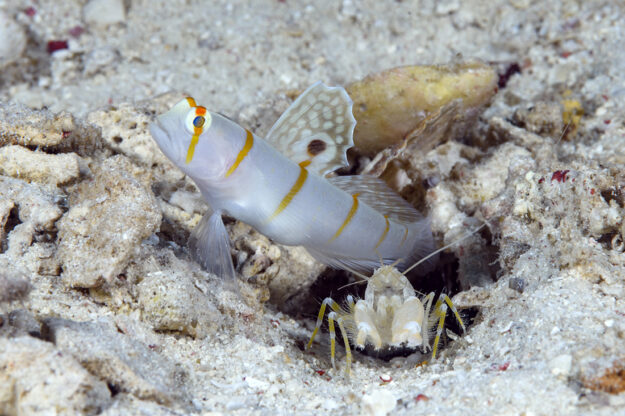
Randall’s shrimp goby (Amblyeleotris randalli), known for its gold bars and halo, will usually pair up with the Alpheus shrimp. Photo by Walt Stearns
Another fascinating group that takes up residence in the sand are the shrimp gobies and their attendant crustacean companions. Often cited as one of nature’s true “odd couples,” the commensurate relationship between these species has one playing lookout while the other does the work of excavation and house cleaning. A more in-depth description of this fascinating relationship can be found in our blog Wakatobi’s Odd Couple.
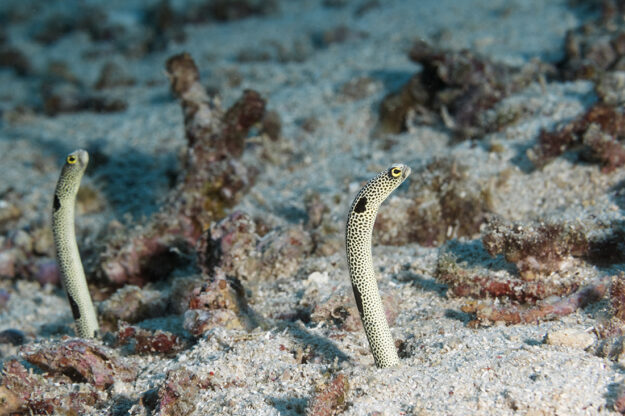
Garden eels are typically found in areas where there is a current that brings drifting plankton. Photo by Wakatobi Resort
On some of Wakatobi’s sand flats, you may come across what at first appears to be a patch of seas grass flowing with the current. Closer inspection may reveal them to be a colony of garden eels. These members of the conger eel family are true homebodies. After spending their first weeks of life drifting with the currents, young garden eels will soon settle on a patch of sand and get to work. These diggers work tail-first and then excrete mucus to cement the sand walls of their tunnel. After moving in, they rarely leave their underground lairs. Garden eels are typically found in areas where there is a current that brings drifting plankton. From the safety of their dens, they will extend about a third of their bodies upward to nab passing morsels.
The Sand Hunters
Like the open expanses of the African Serengeti, the sandy underwater plains of Wakatobi are patrolled by predators. Some roam in the open, while others lie in wait and ambush from concealment. One intriguing group of hunters you may discover trekking the sands is the gunards.
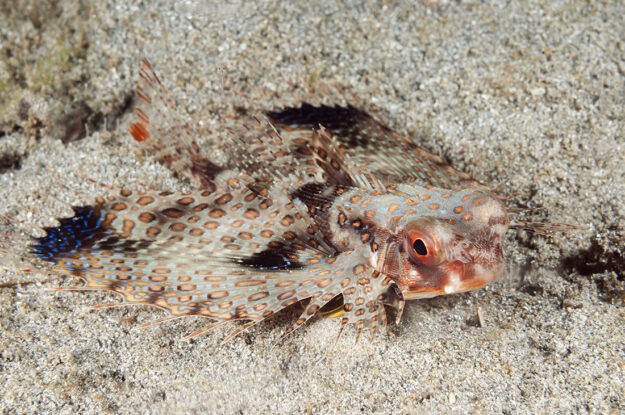
Gunards are often found trekking across the bottom, using their pectoral fins to push off the bottom as they search for small worms and crustaceans. Photo by Walt Stearns
Trekking is an accurate word because these fish are often found walking across the bottom, using their elongated and folded pectoral fins to push off from the bottom as they search for small worms and crustaceans. When startled, gunards may open their pectoral fins to create wing-like shapes that can display bright, iridescent color patterns.
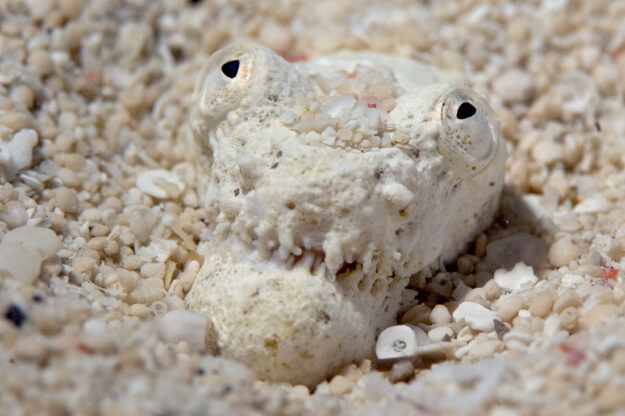
Snake eels have an almost uncanny ability to burrow tail-first into the sand, seemingly disappearing right before a diver’s eyes. Photo by Wakatobi Resort
To locate many of the hunters of the underwater plains, look a bit closer for the ambush predators that make full use of the sand for concealment. Among the more common of these hard-to-see predators are the snake eels, which have an almost uncanny ability to burrow tail-first into the sand, seemingly disappearing right before a diver’s eyes. Of the various species of snake eels that lie hidden and waiting in the sand, the one that is most likely to come out and forage about during daylight is the Harlequin, which has a white and black striped body that mimics the patterns of a banded sea snake. This doppelganger uses its resemblance to the toxic reptile to move about with relative immunity from predators. You can find more on the snake eels of Wakatobi in here> Eel Appeal.
Among the other ambushers that cover themselves in the sand are the stonefish and scorpionfish. And one, in particular, creates a very compelling reason for divers to practice good buoyancy control and keep their hands and bodies off the seabed. The spiny devil scorpionfish has earned a laundry list of ominous nicknames, from Demon Stinger to Bearded Ghoul Fish.

It’s not often that the spiny devil scorpionfish will move about, but when it does it walks across the bottom rather than swim. Photo by Walt Stearns
Most of the time, these fish will conceal themselves in the sand, with only mouth and eyes showing. When they do move about, they often walk across the bottom rather than swim. When feeling threatened, a spiny devil will raise a poison-tipped row of spikes along its back, creating a sharp and toxic deterrent. If caught out in the open, a spiny devil will likely beat a hasty retreat. It’s the ones that are hidden in the sand that create a potentially painful contact.
It will take both luck and very keen eyes to spot one of the most bizarre bottom dwellers in Wakatobi waters. With bulging eyes and a ribbon of what appears to be jagged protruding teeth, a stargazer’s gargoyle-like appearance could earn it a spot in a horror film. But as with most things in nature, there’s a logical explanation for the spooky countenance. The appendages that appear to be teeth growing outside the jaw are actually comb-shaped fringes, which help keep sand out of the fish’s mouth when it is buried literally up to its eyeballs. And those ghoulish eyes are equipped with fluid-filled chambers that can raise the lenses away from the head, allowing the stargazer to see in all directions while remaining concealed.
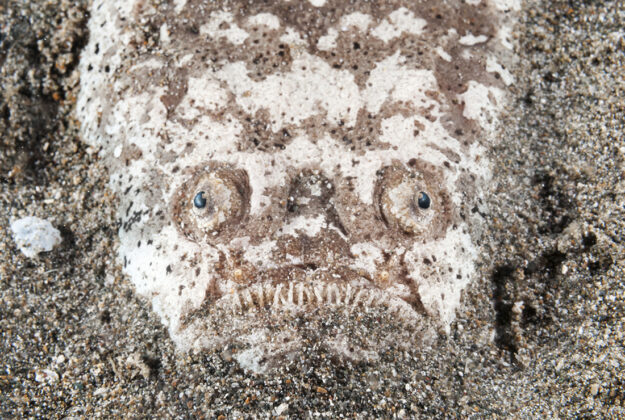
With bulging eyes and a strip of what appears to be jagged teeth, a stargazer’s gargoyle-like appearance could earn it a spot in a horror film. Photo by Walt Stearns
Rather than wait for dinner to pass by, stargazers may go fishing by raising a small strip of skin attached to their lower jaw. Once this lure draws prey within range, a stargazer will quickly bend its spine, then spring out into the open to engulf the victim. This strike takes place in about 30 milliseconds, which is ten times quicker than the blink of an eye. Another weapon in the stargazers arsenal is a specialized muscle tissue located on the top of the head that can generate an electric shock of up to 50 volts. This charge doesn’t have the lethality of an electric eels 500-volt zap, but it will stun and disorient prey, or deter a would-be predator.
Ships of the Desert
Just as camels can roam far and wide across the deserts of the Sahara, there are marine organisms that have adapted to thrive on the ocean’s seemingly barren expanses of sand. The most visually appealing of these is the starfish. These iconic creatures have the most rudimentary central nervous systems and eyespots that can only detect the difference between light and dark. More about starfish on the next page


